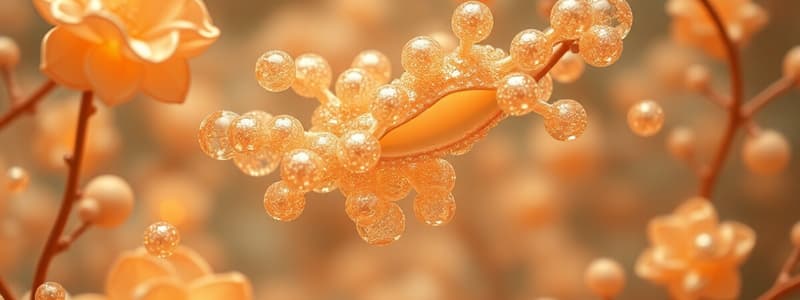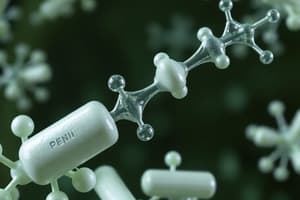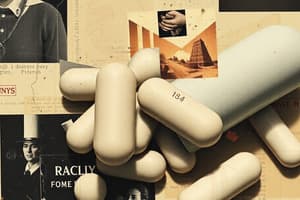Podcast
Questions and Answers
What is the main aim of drug development for staphylococci?
What is the main aim of drug development for staphylococci?
- To improve chemical stability for oral administration (correct)
- To enhance resistance to antibiotic efflux pumps
- To increase the effectiveness of the immune response
- To decrease the range of activity against other bacteria
Which structural component is essential for the binding of penicillins?
Which structural component is essential for the binding of penicillins?
- Amide group (correct)
- Hydroxyl group
- Aromatic ring
- Bicyclic system
What role does the b-lactam ring play in the mechanism of action of penicillins?
What role does the b-lactam ring play in the mechanism of action of penicillins?
- It facilitates the degradation of the bacterial cell wall
- It covalently links to the enzyme’s active site leading to irreversible inhibition (correct)
- It modifies the structure of the antibiotics to prevent bacterial resistance
- It enhances the immune response against bacteria
Why is the bicyclic system important in the development of b-lactams?
Why is the bicyclic system important in the development of b-lactams?
Which statement accurately describes the variations possible in the structure of b-lactams?
Which statement accurately describes the variations possible in the structure of b-lactams?
What compounds are notably transformed by gastric acid in penicillins?
What compounds are notably transformed by gastric acid in penicillins?
Which enzyme is responsible for degrading penicillins?
Which enzyme is responsible for degrading penicillins?
What is a characteristic of oxacillin and its derivatives?
What is a characteristic of oxacillin and its derivatives?
Which of the following statements about the side chains in penicillins is true?
Which of the following statements about the side chains in penicillins is true?
What is the pH level of gastric acid that affects the transformation of penicillins?
What is the pH level of gastric acid that affects the transformation of penicillins?
Which structure represents an ester group in the context of the provided content?
Which structure represents an ester group in the context of the provided content?
What role does the nature of R and R’ groups play in penicillin derivatives?
What role does the nature of R and R’ groups play in penicillin derivatives?
What can penicilloic acid readily decarboxylate to form?
What can penicilloic acid readily decarboxylate to form?
What is the effect of increasing hydrophobicity in penicillin side chains?
What is the effect of increasing hydrophobicity in penicillin side chains?
Which functional group is associated with NH2OH in the context provided?
Which functional group is associated with NH2OH in the context provided?
Which factors contribute to the range of antibiotic activity?
Which factors contribute to the range of antibiotic activity?
The presence of which element in the structure contributes to the classification of a compound as thioester?
The presence of which element in the structure contributes to the classification of a compound as thioester?
Why are some antibiotics orally inactive?
Why are some antibiotics orally inactive?
What is formed from the reaction of penicillins with acidified sodium salts?
What is formed from the reaction of penicillins with acidified sodium salts?
What type of bacteria are oxacillin and its derivatives primarily active against?
What type of bacteria are oxacillin and its derivatives primarily active against?
Which Gram-negative species is NOT indicated as sensitive to carbenicillin?
Which Gram-negative species is NOT indicated as sensitive to carbenicillin?
What characteristic of the prodrugs of ampicillin improves their efficacy?
What characteristic of the prodrugs of ampicillin improves their efficacy?
How does the introduction of an ionized group in penicillins affect its activity?
How does the introduction of an ionized group in penicillins affect its activity?
What is a common characteristic of a compound like R-COOH?
What is a common characteristic of a compound like R-COOH?
What is the main function of the ester in the prodrugs of ampicillin?
What is the main function of the ester in the prodrugs of ampicillin?
What would be a likely effect of penicillinase on penicillins?
What would be a likely effect of penicillinase on penicillins?
Which of the following compounds acts as a prodrug for carbenicillin?
Which of the following compounds acts as a prodrug for carbenicillin?
What role does the bulky penicillin nucleus play in the prodrug activation process?
What role does the bulky penicillin nucleus play in the prodrug activation process?
Which of the following correctly describes a characteristic of bacampicillin?
Which of the following correctly describes a characteristic of bacampicillin?
What happens to the hydrolysed product of the extended ester during drug metabolism?
What happens to the hydrolysed product of the extended ester during drug metabolism?
Carbenicillin has broader activity against Gram-negative bacteria than which of the following antibiotics?
Carbenicillin has broader activity against Gram-negative bacteria than which of the following antibiotics?
Which of the following statements is true regarding the metabolism of methyl ester of ampicillin?
Which of the following statements is true regarding the metabolism of methyl ester of ampicillin?
What chemical group largely determines the classification of carbenicillin as a carboxypenicillin?
What chemical group largely determines the classification of carbenicillin as a carboxypenicillin?
What is a primary reason for the limited success of combinations involving β-lactamase-resistant and β-lactamase-sensitive penicillins?
What is a primary reason for the limited success of combinations involving β-lactamase-resistant and β-lactamase-sensitive penicillins?
What role does clavulanic acid play in the context of β-lactam combination therapy?
What role does clavulanic acid play in the context of β-lactam combination therapy?
Why are free acids of most penicillins unsuitable for oral or parenteral administration?
Why are free acids of most penicillins unsuitable for oral or parenteral administration?
What are salts of penicillins combined with organic bases like benzathine primarily used for?
What are salts of penicillins combined with organic bases like benzathine primarily used for?
Which classification of penicillins indicates that they have been modified from their natural state?
Which classification of penicillins indicates that they have been modified from their natural state?
What characterizes the acid resistance of most penicillins?
What characterizes the acid resistance of most penicillins?
Which type of penicillin is specifically known for being resistant to β-lactamases?
Which type of penicillin is specifically known for being resistant to β-lactamases?
What type of spectrum of activity do penicillins have based on their classification?
What type of spectrum of activity do penicillins have based on their classification?
What is the primary action of penicillin regarding bacterial cell wall synthesis?
What is the primary action of penicillin regarding bacterial cell wall synthesis?
Which structure does penicillin mimic to inhibit bacterial cell wall synthesis?
Which structure does penicillin mimic to inhibit bacterial cell wall synthesis?
Why are Gram +ve bacteria more susceptible to penicillins compared to Gram -ve bacteria?
Why are Gram +ve bacteria more susceptible to penicillins compared to Gram -ve bacteria?
What role do porins play in the resistance of Gram -ve bacteria to penicillins?
What role do porins play in the resistance of Gram -ve bacteria to penicillins?
What is one characteristic of Gram -ve bacteria that contributes to their resistance to penicillin?
What is one characteristic of Gram -ve bacteria that contributes to their resistance to penicillin?
What structural feature of penicillin makes it an effective inhibitor of bacterial cell wall synthesis?
What structural feature of penicillin makes it an effective inhibitor of bacterial cell wall synthesis?
Why is 6-methylpenicillin considered inactive despite its structural similarity to penicillin?
Why is 6-methylpenicillin considered inactive despite its structural similarity to penicillin?
How does the thickness of the cell wall impact the effectiveness of penicillin on Gram +ve bacteria?
How does the thickness of the cell wall impact the effectiveness of penicillin on Gram +ve bacteria?
In what way does penicillin act as an 'umbrella' inhibitor?
In what way does penicillin act as an 'umbrella' inhibitor?
What composition of Gram -ve cell walls contributes to their overall resistance to penicillins?
What composition of Gram -ve cell walls contributes to their overall resistance to penicillins?
Which of the following statements is true regarding the way penicillin affects bacteria?
Which of the following statements is true regarding the way penicillin affects bacteria?
What is a significant factor limiting the effectiveness of penicillin due to bacterial adaptation?
What is a significant factor limiting the effectiveness of penicillin due to bacterial adaptation?
What role does the peptidoglycan layer have in bacterial susceptibility to antibiotics?
What role does the peptidoglycan layer have in bacterial susceptibility to antibiotics?
Flashcards
Penicillin Degradation
Penicillin Degradation
Penicillins can break down due to gastric acid (low pH) and the enzyme penicillinase.
Penicilloic Acid
Penicilloic Acid
A key intermediate in the degradation of penicillin, formed when penicillin interacts with stomach acid.
Penicilloate
Penicilloate
Acidified sodium salt of penicilloic acid.
Decarboxylation
Decarboxylation
Signup and view all the flashcards
Penilloic Acid
Penilloic Acid
Signup and view all the flashcards
Penicillinase
Penicillinase
Signup and view all the flashcards
Gastric Acid
Gastric Acid
Signup and view all the flashcards
pH 2
pH 2
Signup and view all the flashcards
Microbial Enzyme
Microbial Enzyme
Signup and view all the flashcards
Acid-mediated degradation
Acid-mediated degradation
Signup and view all the flashcards
Staphylococci drug development aim
Staphylococci drug development aim
Signup and view all the flashcards
Penicillin's mechanism of action
Penicillin's mechanism of action
Signup and view all the flashcards
Key structure elements in Penicillins SAR
Key structure elements in Penicillins SAR
Signup and view all the flashcards
Penicillin drug binding concept
Penicillin drug binding concept
Signup and view all the flashcards
Limited variations in penicillin structure
Limited variations in penicillin structure
Signup and view all the flashcards
Gram -ve bacteria
Gram -ve bacteria
Signup and view all the flashcards
Active vs. some penicillin G resistant strains
Active vs. some penicillin G resistant strains
Signup and view all the flashcards
Acid sensitive
Acid sensitive
Signup and view all the flashcards
Orally inactive
Orally inactive
Signup and view all the flashcards
Oxacillin (and its derivatives)
Oxacillin (and its derivatives)
Signup and view all the flashcards
b-lactamases
b-lactamases
Signup and view all the flashcards
Effect of 'R' groups
Effect of 'R' groups
Signup and view all the flashcards
Hydrophobic groups and Gram +ve vs. -ve activity
Hydrophobic groups and Gram +ve vs. -ve activity
Signup and view all the flashcards
Penicillin's Target
Penicillin's Target
Signup and view all the flashcards
D-Ala-D-Ala
D-Ala-D-Ala
Signup and view all the flashcards
Penicillin Mimicry
Penicillin Mimicry
Signup and view all the flashcards
Transpeptidase Enzyme
Transpeptidase Enzyme
Signup and view all the flashcards
Blocked Cell Wall Synthesis
Blocked Cell Wall Synthesis
Signup and view all the flashcards
Porins in Gram -ve
Porins in Gram -ve
Signup and view all the flashcards
Lipopolysaccharide Barrier
Lipopolysaccharide Barrier
Signup and view all the flashcards
High Enzyme Levels
High Enzyme Levels
Signup and view all the flashcards
Penicillin Resistance
Penicillin Resistance
Signup and view all the flashcards
'Umbrella' Inhibition
'Umbrella' Inhibition
Signup and view all the flashcards
Acyl-D-Ala-D-Ala
Acyl-D-Ala-D-Ala
Signup and view all the flashcards
6-methylpenicillin Inactivity
6-methylpenicillin Inactivity
Signup and view all the flashcards
Synergy
Synergy
Signup and view all the flashcards
Penicillinase-resistant penicillin
Penicillinase-resistant penicillin
Signup and view all the flashcards
Depot forms
Depot forms
Signup and view all the flashcards
Amphoteric
Amphoteric
Signup and view all the flashcards
pKa value
pKa value
Signup and view all the flashcards
Penicillin classification
Penicillin classification
Signup and view all the flashcards
Carbenicillin
Carbenicillin
Signup and view all the flashcards
Prodrugs
Prodrugs
Signup and view all the flashcards
Pivampicillin
Pivampicillin
Signup and view all the flashcards
Talampicillin
Talampicillin
Signup and view all the flashcards
Bacampicillin
Bacampicillin
Signup and view all the flashcards
Esterase Enzyme
Esterase Enzyme
Signup and view all the flashcards
Carboxypenicillins
Carboxypenicillins
Signup and view all the flashcards
Carfecillin
Carfecillin
Signup and view all the flashcards
Increased Cell Membrane Permeability
Increased Cell Membrane Permeability
Signup and view all the flashcards
Prodrug Activation
Prodrug Activation
Signup and view all the flashcards
Study Notes
Antibiotics
- Waksman proposed a definition of antibiotics in 1942 as substances produced by microorganisms that inhibit or destroy other microorganisms (bacteria, mycobacteria, fungi, protozoa, or viruses).
- Benedict and Langlykke defined antibiotics in 1947 as chemical compounds derived from living organisms that inhibit the life processes of microorganisms at low concentrations.
- Modern antibiotics may include synthesized compounds.
- Antibiotics are specific chemicals derived from living organisms or synthesized as structural analogs, inhibiting other microorganisms.
Classification of Antibiotics
- A substance is classified as an antibiotic if it fulfills four conditions:
- It is a product of metabolism or duplicated from a chemical synthesis.
- It is synthesized as a structural analog of an antibiotic.
- It antagonizes the growth or survival of one or more species of microorganisms.
- It is effective in low concentrations.
Penicillins
- Penicillins are antibacterial agents that inhibit bacterial cell wall synthesis.
- Discovered by Sir Alexander Fleming in 1928 from a fungal colony.
- Isolated and purified by Florey, Chain, and Abraham at Oxford University (1938).
- First successful clinical trial conducted in 1941.
- Produced by large-scale fermentation (1944).
- Chemical structure elucidated via X-ray crystallography (1945).
- Full chemical synthesis developed by Sheehan in 1957.
- Development of semi-synthetic penicillins (1958-60) along with the discovery of clavulanic acid and beta-lactamase inhibitors.
Structure of Penicillins
- The penam ring is composed of a cysteine and a valine residue.
- The Beta-lactam ring and the thiazolidine ring are not coplanar but are folded, with an angle of 117°.
- This non-planarity suppresses normal amide resonance.
- The unshared electrons are far to interact with resonance.
- The beta-lactam ring is highly reactive and unstable.
Mechanism of Action
- Penicillins inhibit the bacterial enzyme transpeptidase, crucial for bacterial cell wall synthesis.
- Penicillins acylate bacterial D-transpeptidase, forming a covalent bond to the enzyme's active site, leading to irreversible inhibition.
- The beta-lactam ring plays a key role in the inhibition mechanism.
- Penicillin blocks the final cross-linking stage of cell wall synthesis by reacting with transpeptidase.
Resistance to Penicillins
- Gram-negative bacteria have an outer membrane that prevents penicillin access.
- Penicillins can only cross the outer membrane via porins.
- High levels of transpeptidases and the presence of beta-lactamases in the periplasmic space contribute to penicillin resistance.
- Mutations and efflux mechanisms also contribute to resistance.
Penicillin Analogues
- Penicillin analogs are prepared through fermentation and total synthesis, with limited yields from total synthesis.
- By varying the carboxylic acid in the fermentation medium and employing total synthesis.
- Semi-synthetic procedures use naturally occurring structures as starting materials for analog synthesis.
Problems with Penicillin G
- Sensitivity to stomach acids.
- Sensitivity to beta-lactamases.
- Limited range of activity.
Range of Activity
- Hydrophobic side chains lead to high activity against Gram-positive bacteria and low activity against Gram-negative bacteria.
- Hydrophilic side chains increase activity against Gram-negative bacteria.
- Introduction of certain groups to increase activity and range.
- Prodrugs like those formed for ampicillin have increased cell membrane permeability and polar carboxylic acid groups masked by ester groups, improving oral and parenteral activity, allowing longer action.
Beta-Lactamase Inhibitors
- The strategy of using beta-lactamase inhibitors in combination with beta-lactamase-sensitive penicillins, although promising, has been limited.
- Factors that contribute to this failure include the lipophilic nature of penicillinase-resistant penicillins, the reversible binding to the beta-lactamase, the induction of beta-lactamases, and poor penetration.
- Discovery of clavulanic acid (a naturally occurring inhibitor) has enabled renewed interest in penicillin combination therapies.
Chemical Properties of Penicillins
- Most penicillins are acidic with pKa values between 2.5 to 3.0.
- The free acid form isn't suitable for oral administration.
- The sodium and potassium salts are more soluble in water and readily absorbed through oral and parenteral administration.
- Some salts of penicillins with organic bases, e.g., benzathine, procaine, and hydrabamine, have limited water solubility, acting as depot forms for long-term drug delivery.
Studying That Suits You
Use AI to generate personalized quizzes and flashcards to suit your learning preferences.





